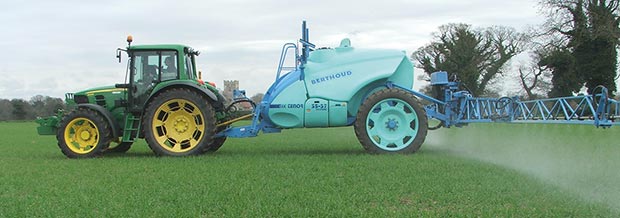Agronomy Update
27th November 2017
The jobs list on arable farms is growing with fungicide applications foremost in growers’ minds
High early disease pressure means about half the wheats in his area and further afield received an early holding spray, says Norfolk-based Agrovista agronomist Craig Green, who advises that both these and, as-yet untreated, crops all now need a robust T0 application to keep ahead of septoria, yellow and brown rusts and eyespot.
Treatments will be based on Ceando (epoxiconazole + metrafenone) at 0.50.65 litres/ha plus chlorothalonil at 1 litre/ha to boost protectant activity against septoria. The mix of metrafenone and epoxiconazole shows good efficacy against all those diseases plus mildew. Eyespot could be very prevalent this year given the amount of early drilling and the warm, wet winter, says Craig.
Growers yet to finish their black-grass programmes could add Horus (iodosulfuron + mesosulfuron) to the mix, he adds. He will also be advising Afrisect (cypermethrin) against aphids carrying barley yellow dwarf virus. This could be mixed with the fungicide but not if Horus is in the tank its either or. The same applies for growth regulator. Canopy (mepiquat + prohexadione) at about one-third rate will be targeted at smaller crops to maintain tillers and boost rooting. A 2 litres/ha dose of chlormequat will strengthen the stem base in lush crops. Some wheat crops drilled after sugar beet that was lifted in less-than-ideal conditions look backward.

Agrovista agronomist Craig Green
They will need spoon-feeding; little and often foliar applications such as Mega Phos and other nutrients/precursors can help avoid transient deficiencies apply them as long as they are needed whenever you are travelling through the crop. Most barleys are heading for T1. All should have had a T0 and, for T1, well predominantly use Jaunt at 0.6 litres/ha, a three-quarter rate it contains prothioconazole and two strobilurins making it one of the best against rusts, net blotch and rhynchosporium.
Growth regulator will be added for wheat as needed, with magnesium as required, says Craig. Oilseed rape crops near or at flowering will receive their first sclerotinia spray before long. We also need to help retain green leaf area. I’ll be recommending Galileo which contains picoxystrobin, both for disease control and the greening effect.
While more forward crops will have been treated for pollen beetle, the pest will be colonising later stands from green bud onwards. Craig urges growers to check thresholds (see panel) and spray only if these are reached, but not after flowering has started as there is no longer a risk of damage. Rumo (indoxacarb) retains good control levels and has strong anti-feeding properties, he adds.Some broad-leaved weeds will need tidying up in wheats.
Hormone weedkillers like High Load Mircam (mecoprop-p + dicamba) or Duplosan (mecoprop-p) will take out most problem weeds; Spitfire (florasulam + fluroxypyr) is useful on bigger cleavers, he says. Some late-drilled wheat after beet may not have had any herbicide yet. Advice must be aimed at individual crops, bearing in mind target weed and crop condition, to come up with appropriate products, timing and doses. Fluroxypyr (eg Starane, Gal-Gone) and Duplosan will clear up cleavers in barley most other broad-leaved weeds have been tackled at T0. Wild oats should be treated with Axial (florasuam + pinoxaden) from any time now’ adds Craig.
‘Do ensure crops have grown out of any stress some have been in wet soils for a long time and are pretty soft given the lack of frosts. They must be actively growing or they could be knocked back, he suggests. Oilseed rape growers should give some thought to variety choice next autumn, he adds. There will be no neonicotinoid seed treatments. There are several things we can do that will help, but for now it will pay to consider early vigour this helps crops grow away from trouble.
Growers should assess how varieties performed on their farm this season and consider replacing those that got off to a slower start then they would have liked.
Other crop notes:
Maize: – Spray long-term ploughing with glyphosate to avoid transplanting large weeds into the seedbed
– Remove compaction below plough pan where possible this year especially there could be much smearing at plough depth too.
– Take time to prepare seedbeds waiting for the right conditions is more important than date
Sugar beet: – Do plant counts at emergence to help manage late canopy management
– Put down a residual herbicide barrier (eg chloridazon or metamitron depending on weed spectrum plenty of moisture this year will help activity)
– Follow up with contact chemistry and residual partner actives and dose according to weed spectrum
Pollen beetle thresholds – 25 beetles per plant if fewer than 30 plants/m2
– 18 beetles per plant if 30-50 plants/m2
– 11 beetles per plant if 50-70 plants/m2
– 7 beetles per plant if more than 70 plants/m2
– Estimate plants/m2 by counting number of plants per square foot and multiplying by 11. Repeat in several areas of field
– Sample 10 plants along a 30m line from middle of headland into crop
(Source HGCA)* Craig Green is an agronomist with Agrovista and is based at the companys Great Ellingham depot, Norfolk (Craig.Green@agrovista.co.uk).

